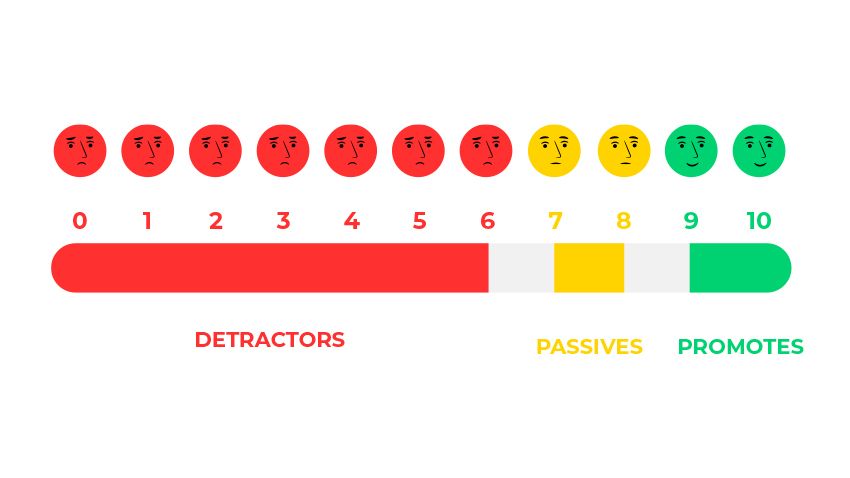But there’s more to it than just keeping an eye on the score. Let’s see further on how the NPS score it’s calculated, what it means, and how you can use it to get more and happier customers.
Measuring the NPS score is essential for businesses in most industries. Looking at post-purchase and post-delivery customer feedback, and using that feedback to adjust, improves loyalty, customer lifetime value, and predicts whether your company is on the right track.
Companies and institutions of all sizes in all industries measure their NPS score. Think about Procter&Gamble, University of California – Berkeley, Orange, Virgin Media, Porsche, Zappos, PayPal, Microsoft, Sony, BBC – just to name a few. But what does the NPS score monitoring begin with? If you’ve been browsing the www for log enough, you might have encountered a question in the lines of:“On a scale from 0 to 10, how likely are you to recommend us to a friend?”.Well, this is exactly the NPS question that companies use to get a picture about how their visitors and customers feel about what they offer.
The NPS score formula

Let’s say you’ve sent an e-mail to your customer database asking them how likely they are to recommend you.
Respondents who reply with grades from 0 to 6 are considered Detractors. Those who reply with grades 7 and 8 are considered Passives, and people who give scores of 9 and 10 are Promoters.The formula for the NPS score is then calculated by subtracting the percentage of detractors from the percentage of promoters.Formula:%Promoters – %Detractors = NPS score
Obviously, the higher the score, the happier your customers are and viceversa.
But keep in mind that simply asking the question is not enough. Take one extra step and, depending on their reply, ask them a follow up question. The e-mail survey could redirect to a special page on your shop where you can ask Detractors and Passives what went wrong, and Promoters – what went right.
Analysing the NPS score
The first thing that you can do when analyzing your NPS responses is to take a look at each segment of respondents.
The Detractors (grades 0-6) are the clients who were unhappy for some reason with what they bought or the customer experience. They are very likely to spread negative word of mouth and damage your brand image. Our suggestion: use their feedback to improve.The Passives (grades 7-8) are those clients who are happy but not impressed by their overall experience with your company. It’s important to find ways of turning them into Promoters. Also, keep in mind that they can be easily won by the competition, because they’re not your loyal customers.
The Promoters (grades 9 and 10) are your company’s best customers. In the NPS score analyses that we conduct for our clients at Data Revolt Agency, we want to find out from this segment all the things that the business is doing right, and then try to create similar audiences that can expand their pool of happy clients.
By keeping an eye on your NPS score for a long term, you’ll be able to notice how it shifts, and correlate it with any business decisions or changes that might have influenced it.
Types of NPS scores
There are several steps in the customer journey where you can include an NPS score. Let’s say that you are an e-commerce business and sell products on your e-shop. In this case, your key moments are right after purchase and right after delivery (and ideally, product trial). This means that you can trigger both post purchase NPS, as well as a post delivery NPS.The post-purchase NPS consists of getting the customer feedback right after placing their order. Usually this is done by including the NPS question in the Thank You page after their transaction went through.The purpose of a post purchase NPS is to find out the customer feedback about the ordering experience. They’ll rate you according to how easy it was to find the products that they needed, how easy it was to add them to cart, how smooth the checkout process was, and so on.
The post-delivery NPS should be triggered a few days after the product was delivered. This depends on your industry, of course. Just consider a number of days that the customer would need to receive the product and use it or have some sort of experience with it.
Then, you can compare the NPS scores given by the same customers. Did you meet their expectations? Were they happy after placing the order but had a bad experience with the delivery man or with the product itself?
What to do after you get the NPS scores
After your customers start replying to your NPS survey, it’s time to do something about their feedback.Take the positive feedback and learn from it. All the things that the customers appreciate are value propositions that you can use to attract new customers. This can even be done as mentioned before, by creating audiences for your performance campaigns.
With their consent, you can even use some of the good reviews as testimonials on your site.The negative feedback is the more difficult part. Ideally, you should treat the complaints and objections as soon as possible.
Reach out to the unhappy customers, find out what their problems were, and try to solve them. Maybe they called the customer service but didn’t get the help they needed. Maybe their products arrived broken. Find out what went wrong so that you can do better next time.
It’s great to at least contact them, tell them that you’re sorry that they had a bad experience and that you’re trying to do something about it. Showing that you care can sometimes turn a lost customer into a loyal one. Besides, remember that these unhappy customers can negatively influence your company’s growth by spreading the word.
If you don’t have enough resources to contact each and every Detractor, then use what you can, according to how important they are to your business. For example, for your VIP customers (those who have spent more, bought more often) it’s worth putting in the effort of a phone call. E-mail contact will be enough in most cases for low value customers. It’s still much better than doing nothing and just ignoring their complaints.
Measuring NPS by segment
If you want to go even deeper, you can start measuring NPS according to different segments.
One way would be measuring the NPS score given by customers according to their RFM score (Recency, Frequency, and Monetary value).
You’ll be able to see whether customers who haven’t bought from you in a while are Detractors, or what makes others come back and be loyal.Another way of segmenting the NPS even more is to look at the customer baskets, and measure the score based on their purchases. Are people usually happier with a brand? Does another brand receive low scores? These are all hints that can help your commercial policy.By using the NPS score you’ll be permanently aware of the churn risk, how opinions and feedback change over time, and most importantly make the improvements that your customers are asking for.

